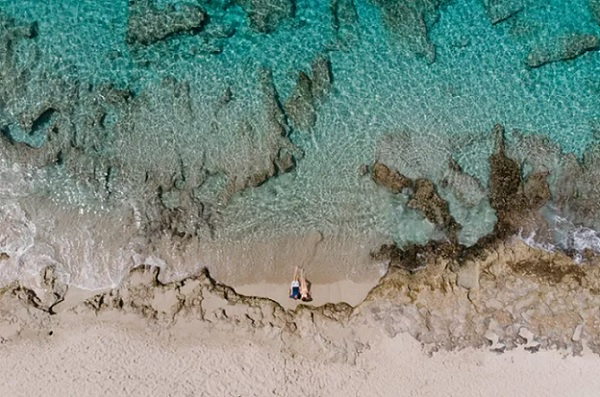
[Many thanks to Michael Connors for bringing this item to our attention.] Carly Thornell (Travel+Leisure) writes, “Low-impact tourism may not be the first thing we associate with the Caribbean. But St. Croix is a bright, eco-friendly exception.” See full article, and marvelous photos by Meredith Zimmerman, at Travel+Leisure.
A cheery bartender wearing a tropical madras kerchief made a passion-fruit cocktail with Mutiny Island, a local vodka distilled from breadfruit. A couple of booths away, a chef struggled to keep his toque in place as he leaned over a steaming cauldron filled with a pork-and-pumpkin stew made with ingredients sold at the nearby farmers market. Under a white tent, another chef served a hearty birria, a stew made with the meat of Boer goats, like the ones eating hay just a few yards away.
This was Bush Cook, a three-day community fair held last October at Sejah Farm, a 15-acre livestock and agricultural center in the jungly heart of St. Croix. Under a sweltering sun, two dozen people competed for bragging rights while offering visitors a chance to sample the culinary bounty of the island. But as I learned during a four-day trip to St. Croix, sustainable farming and ecotourism are not limited to festivals like this one. They have become a part of its ethos year-round.
More than 450 small farms operate on this 28-mile-long island, a threefold increase since 2007, according to a U.S. Department of Agriculture report. Solar panels are everywhere — installed on houses, in lush fields, and atop new hotels. Along beachfronts, bright streetlamps have been replaced with dimmer red lights to help baby sea turtles reach the sea. And the coral reefs are being restored and protected by public and private efforts.
It helps that St. Croix, the largest of the U.S. Virgin Islands, is not overdeveloped and much of its natural beauty remains unspoiled. There are limited nonstop flights from major cities, relatively few cruise ships, and no mega-resorts — just a smattering of boutique hotels. One of the newest is Waves Cane Bay, an 11-suite resort that overlooks a turquoise cove known for its great snorkeling. The hotel strives for sustainability, including collecting rainwater in cisterns for bathing and cooking. There are nice design touches, too. After checking in, I found myself snapping photos of my room’s wood-beamed ceilings, marble-lined bathroom, rustic bamboo furniture, and enormous veranda — just in case I ever wanted to redo my home like an eco-chic Caribbean resort.
I was tempted to lounge outside in my pajamas and watch the sunset, but I had to try the hotel’s seafood restaurant, Ama, located just below my suite and surrounded by crashing waves. The day’s catch included lionfish, an invasive species that threatens the fragile coral ecosystem. The spiky fish was prepared as a ceviche, tossed with coconut milk, citrus, and microgreens — a delicious way to do my part for the environment.
The following morning, I wanted to get a closer look at the marine life, so I met up with Ryan Flegal and Corina Marks, a husband-and-wife team who offer dives at the Feather Leaf Inn, an eco-lodge facing Butler Bay. “We’re just citizen scientists passionate about ecology,” Flegal said. But the waves were too choppy for diving that day, so instead I drove 30 minutes to the Coral Innovation Hub, a new research center that is studying novel breeding methods that help to restore reefs faster. Located at Estate Little Princess, which was once a sugar plantation, the 25-acre preserve is dotted with the ruins of 18th-century Danish buildings where enslaved Africans once worked, as well as lush plant life, high-tech trailers, and aquariums sheltered by white tents. Peeking inside one, I watched marine biologists in lab coats chip off small chunks of coral to be replanted in the sea.
The next morning I went on a sunrise hike at Jack & Isaac Bay Preserve, a 300-acre park, accompanied by Celeste Jarvis, a director of the Virgin Islands’ Nature Conservancy, which established the preserve in 1999. During our two-hour excursion, which meandered through raspy seagrass and dunes crawling with hermit crabs, Jarvis recalled how, when she was a child, poachers would prowl these trails in search of turtle eggs to sell or eat. Thankfully, through public education and enforcement, the poaching has been curtailed, and she estimated that 99 percent of turtle eggs are protected these days.
When we reached the shore, Jarvis had me gently scoop up a pile of white sand. As it slipped through my fingers, the rubbery fragments of turtle eggshells were left behind — a telltale sign of another successful hatching season. If I had come a few weeks earlier, she added, I might have seen hundreds of baby green sea turtles flip-flopping their way toward the water.
My turtle timing may have been off, but my visit coincided with the new moon, and the dark night provided perfect conditions for viewing the bioluminescence at Salt River Bay. Just before sundown, I joined a dozen couples for a two-hour trip organized by Sea Thru Kayaks VI. After climbing into a clear-bottomed kayak, we paddled our way into the bay. Moments later, the water began to glow with the blue-green haze of single-celled plankton. With each swish of the paddle, a glittery constellation formed underwater. [. . .]
For full article, see https://www.travelandleisure.com/eco-friendly-tourism-saint-croix-caribbean-8419700
[Photos above by Meredith Zimmerman: 1) Sunbathers find a secluded cove on St. Croix, the largest of the U.S. Virgin Islands; 2) yellowtail snappers; 3) green sea turtle.]
[Many thanks to Michael Connors for bringing this item to our attention.] Carly Thornell (Travel+Leisure) writes, “Low-impact tourism may not be the first thing we associate with the Caribbean. But St. Croix is a bright, eco-friendly exception.” See full article, and marvelous photos by Meredith Zimmerman, at Travel+Leisure. A cheery bartender wearing a tropical madras









